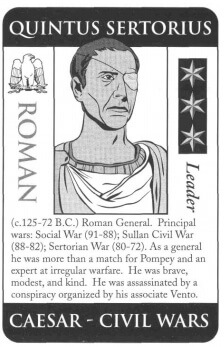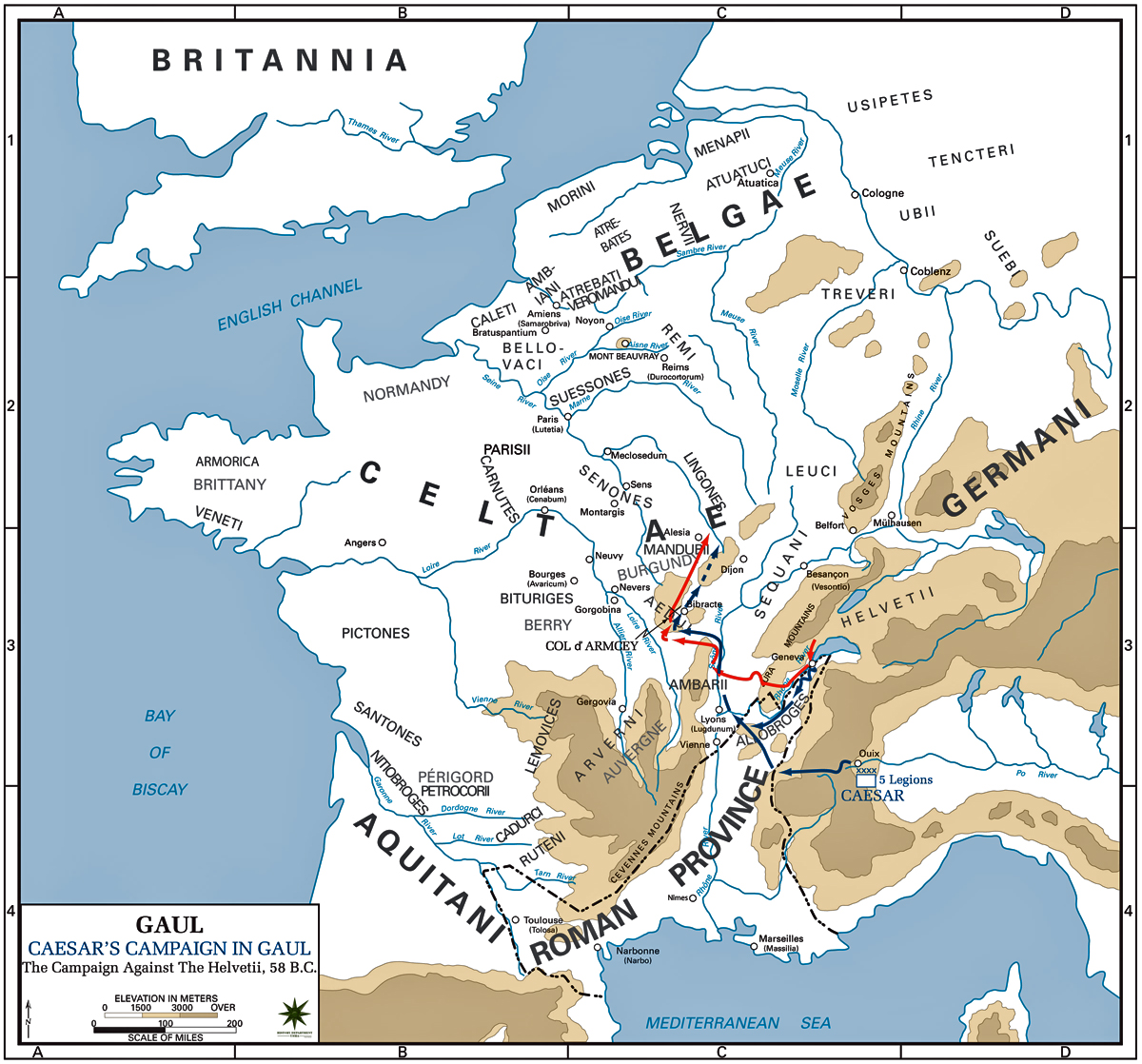Over the past several months I have been seeking a starting point for a comparative look at two Generals from the Mid-Late Roman Empire. I had been thinking that not only do I want to examine two great generals but really two that lead by example and faced real challenges in their roles as leaders. It would be ideal to for contrast purposes to see two generals who were alive at the same time and fought with similar weapons systems, tactics and forces.
This lead inevitably to the obvious comparison of Caesar and Pompey. They fit the bill in many respects, but had enough differences in style to make for an interesting set of After Action Reports (AARs). The question was where to start? Where do we pick up the thread of how these men came to be who they are when they finally face each others forces on the field of battle?
Now we cant know all of this for certain, we cannot divine their minds eye, their intent, the aspirations of their souls. We can however establish some baseline to compare against, and at the very least look at how they approached each engagement as they progressed in their careers. For each ones careers were very markedly different in scope, purpose and end result.
I’ve been reading quiet a bit of the Sertorian War 80-72 B.C. It looks like a great starting point to the exploring who was the young Pompey. With the added benefit of being able to see Quintus Sertorius in action.
Sertorius is famous in his own right and worthy of reading about. As a notable leader fighting against the dictatorship of Sulla after Sullan forces defeated Marius, Sertorius refused to capitulate and defeated a string Roman generals sent to bring him to heel. In the end where warfare failed, betrayal did not.
Sertorius earned his stripes the old fashioned way. In combat, leading men in desperate situations. He was in his own mind always fighting for the good of Rome despite conducting the majority of this campaign in Spain. Like all Romans of note he came from aristocracy, but not a notable family per se. His fame was won firstly in the courts and orating then in the battlefield.
After surviving Arausio (105 B.C). by swimming wounded across a river without losing his weapons, he served under Marius and Strabo (Pompeys father) in the Social War against the Italian Allies.
As we may recall Marius & Cinnas army re took Italy from Sullas army whilst he was away fighting Mithridates. By the time Sulla returned Sertorius was Praetor and Marius was dead. Upon Sullas return Sertorius and others were proscribed.
Sertorius was by now serving in Spain as Governor and had rooted out all Sullan supporters and endeared himself to the locals. In 81 B.C. Sulla sent the first of several generals to remove Sertorius’s influence.
Two battles come to mind when I think of Sertorius and his unique skills; Baetis River and the Battle of Langobritae. They demonstrate his ability to use Allied forces, and fight guerilla style versus a numerically larger and arguably better trained and supplied army. We will examine these two conflicts prior to digging into 77 B.C. when young Pompey arrives in Spain.
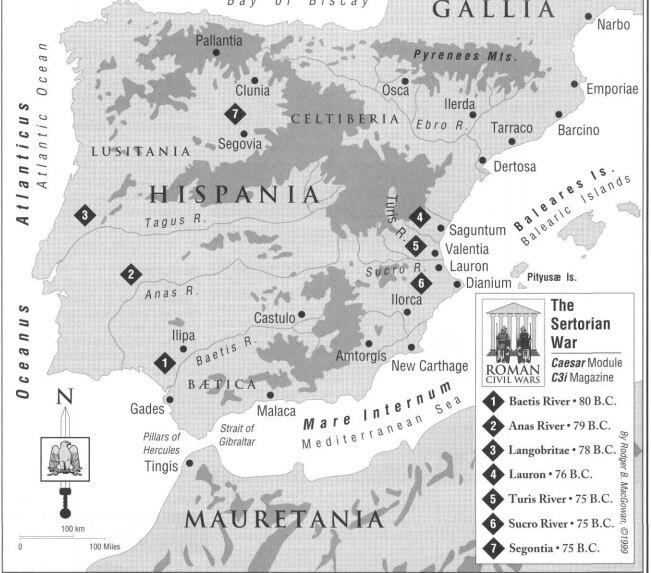
I think that exploring the battles that lead to Pompeys involvement in the Sertorian War will give us some insight to Pompey’s development based upon who he was going to be fighting against. For there is precious little to go on from his prior activities to this point. The Sertorian conflict came to a head in the Battles of Lauron and Sucro River. These two will to give us a feel for the type of fighting Pompey was engaged in against Sertorius.

We do know that Pompey was the wealthy son of a Senator, who raised a full Legion, paid for it and rode to Sullas aid, fighting in personal combat along the way and winning several victories in his travels to join up with Sulla. Such were his successes that he was hailed Imperator by Sulla upon entry to the camp. Not bad for a 23 year old!
There is of course more to the story of Pompey, but we are here to focus on Generalship in this instance, not regurgitation of more well versed historians and writers. If you are interested in Pompeys background see In the Name of Rome by Adrian Goldsworthy.
After 72 B.C. and at the end of the Sertorian War, Pompey was engaged near the end of the Servile Wars, much to the dismay of Crassus, stealing some of his glory, thus setting the stage for future rivalry.
Then in 71 B.C. he for the first time participated “in” the system instead of outside the system. As Senator, and Consul he was now a part of Roman public life in a legitimate fashion versus self financed. It is at this point that the military career of Pompey takes a liquid turn.
He is issued an expansive command to deal with the Pirate menace that was causing economic and political issues in Rome, with 120,000 troops and 500 ships he conquers the problem in short order. On the back of this success he is tasked with engaging the Pontic forces of resurgent Mithridates.
Early in 74 BC Nicomedes III gave on his deathbed his entire kingdom to Rome. I believe he did this because he wanted stability and protection for his people. He himself had been removed from and restored to the throne three times. The senate immediately declared Bithynia a province.
Mithridates III invaded and conquered Bithynia, Pontus, and several other regions in Asia Minor. In the middle of 74, when the senate heard of Mithridates’s action, it sent an army to recover the province. After some years, Pompey took over the command in 67.
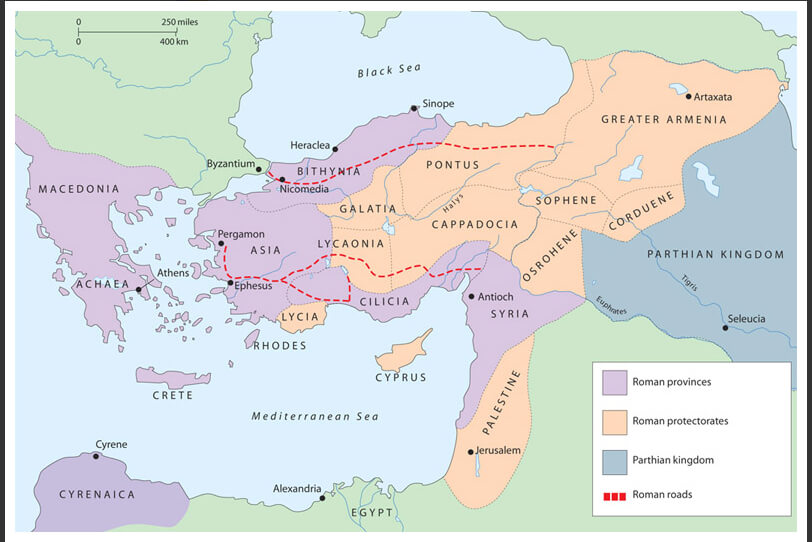
As far as military actions are concerned the first years fighting was remarkably like Sertorius’s tactics. Pompey out maneuvered and out thought Mithridates, and then won over the Parthian king Tigranes rather than fight him. I have not been able to source any specific details that allow us to recreate the final ambush that destroyed 10,000 of Mithridates men as a result of a forced march and ambuscade. But if I do you can be sure we will bring it to the table.
The War for Albania, as a resurgent Mithridates made a last attempt to fight the forces of Rome. Whilst there is a C&C Ancients scenario I see nothing similar for Great Battles of History system. If you see one please advise!! In 65 he recovered Bithynia and gave it a provincial constitution. He added part of Pontus to Bithynia. Mithridates’s capture in 63 BC ended the Third Mithridatean War.
With Caesar we have a vastly different story and significantly more detail due to his own writings and those of historians from the era. Our contemplation of Pompey has relied upon Plutarch, Dio, Strabo and Appian.
The Gallic Wars honed Caesar as a Leader and the volumes of detail in the Commentarii (Commentaries) allowing us a rare if not lop sided, politically motivated view into the Generalship of Caesar thru the 6 years of fighting the Gaulish Tribes.
Caesars background is well known, and characterized by lavish spending, flamboyant style and a generation of dislike by his contemporaries. Cast as a rake and a womanizer he was a threat to Senate stability as he grew in influence. He managed to wrangle the Governor-ship of Cisalpine Gaul & Illyricum just a short time after a term in Spain where he declined a Triumph in order to obtain this consul position. Caesar was also awarded Transalpine Gaul upon the death of the sitting Governor.
This was the opportunity and natural destiny that Caesar craved. He turned this Consulship into one of conquest and subjugation of most of the Tribal groups in the region.
The Helvetii were defeated at the Battle of Bibcrate in 58 B.C. Then he quickly moved to eliminate the newly ‘created’ threat of Ariovistus (Germanic tribe) that same year. Early in 57 B.C. Caesar marched North to subdue the Nervii whom Caesar considered the most fierce of opponents. The Nervii fought at The Battle of Sambre. Both of which represent excellent examples of his leadership style. The Sambre River represents a Roman force that was caught unprepared and Caesar had to rely on force of personality to rally his men and have them stand their ground. Whereas the Bibcrate was Caesars first set piece battle and one that involved disproportionate numbers, and a surprise flanking maneuver by the enemy.
Map detail shows Caesars major actions against the Helvetii. On the heels of victory here Caesar launched punitive actions to protect the Rembi tribe from incursion by the Nervii a Belgic tribe. Then quickly moved to
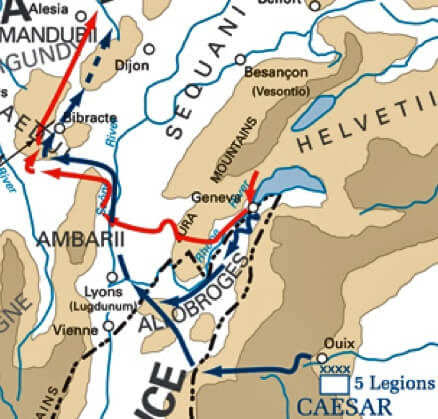
secure his gains in the region. Caesar did not face defeat often. Either by brilliance, heroic leadership or luck he thwarted his foes at nearly every turn. The Battle of Gergovia, stands as the rare defeat for Caesar.

Vercingetorix, had rallied several tribes to his banner under the Averni. Now besieged by Caesar where his plan to draw Averni forces off of the hilltop failed. The subsequent counter attack by the Averni, nearly routed the entire Roman force, but for Caesar and his vaunted X th Legions intervention.
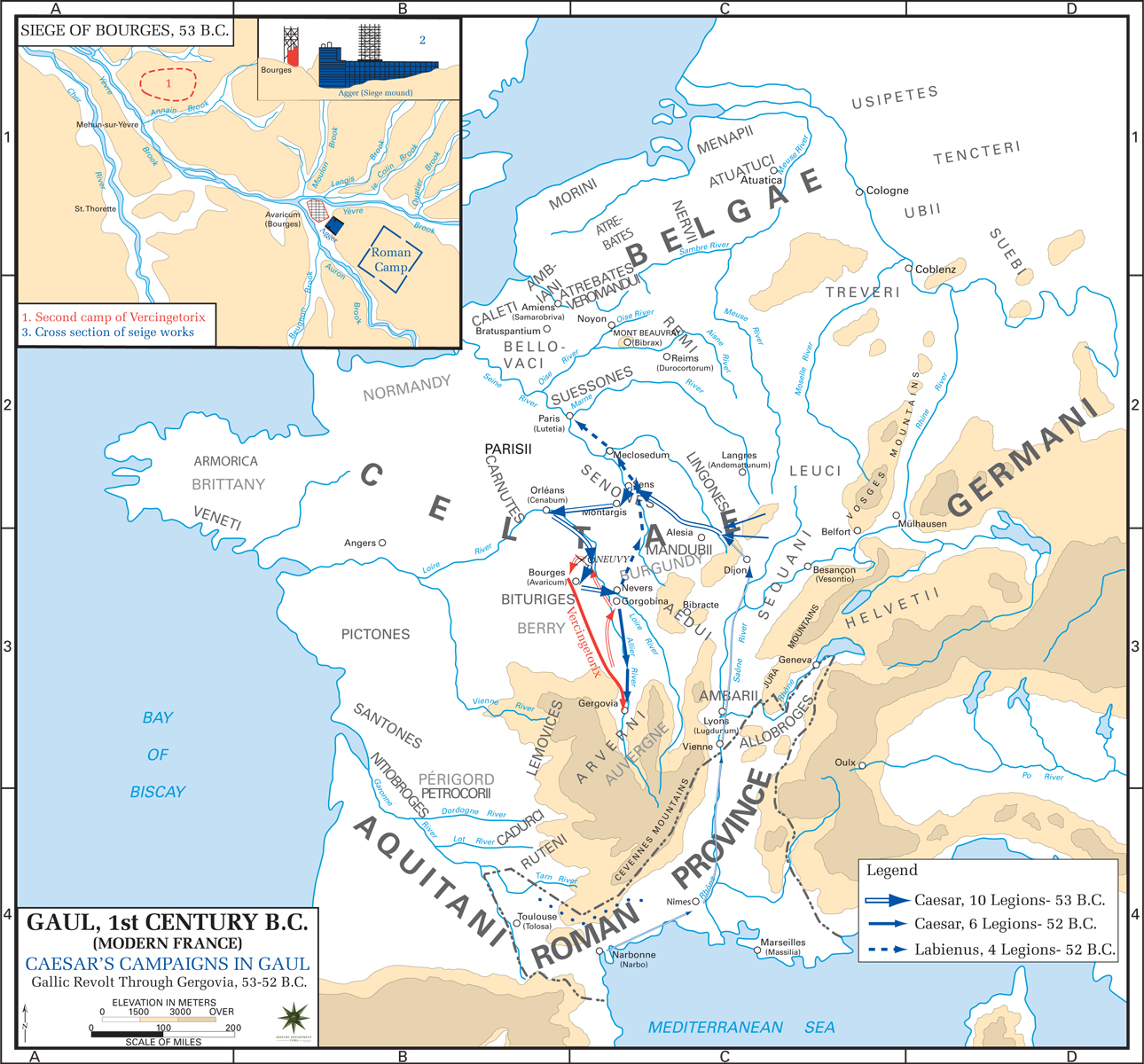
Yet even this loss at Gergovia, which encouraged further rebel forces to join up it was ultimately reversed after his amazing leadership at the Siege of Alesia. Which we will deal with in a detailed separate play thru if we have time.
Two Generals One Rome
That would then lead us to a natural place for the assessment and viewing of the set piece battles between two titans of history in the Second Roman Civil War.
We will examine the circumstances and actions in each battle and follow as best we can the thinking of these two men in a time of crisis for the Empire. The Civil War action was complex and ultimately at least to my mind tragic. As little was achieved after its end. But we are here to see how Generals use their skills, not the consequences of their application. Dyrrhachium, Pharsalus and of course Munda in 45 B.C will all be played through. It may well be remiss of us if we don’t take a sneak peak at Thapsus as well, even tho it is Mettelus Scipio who leads rather than Pompey! 😉
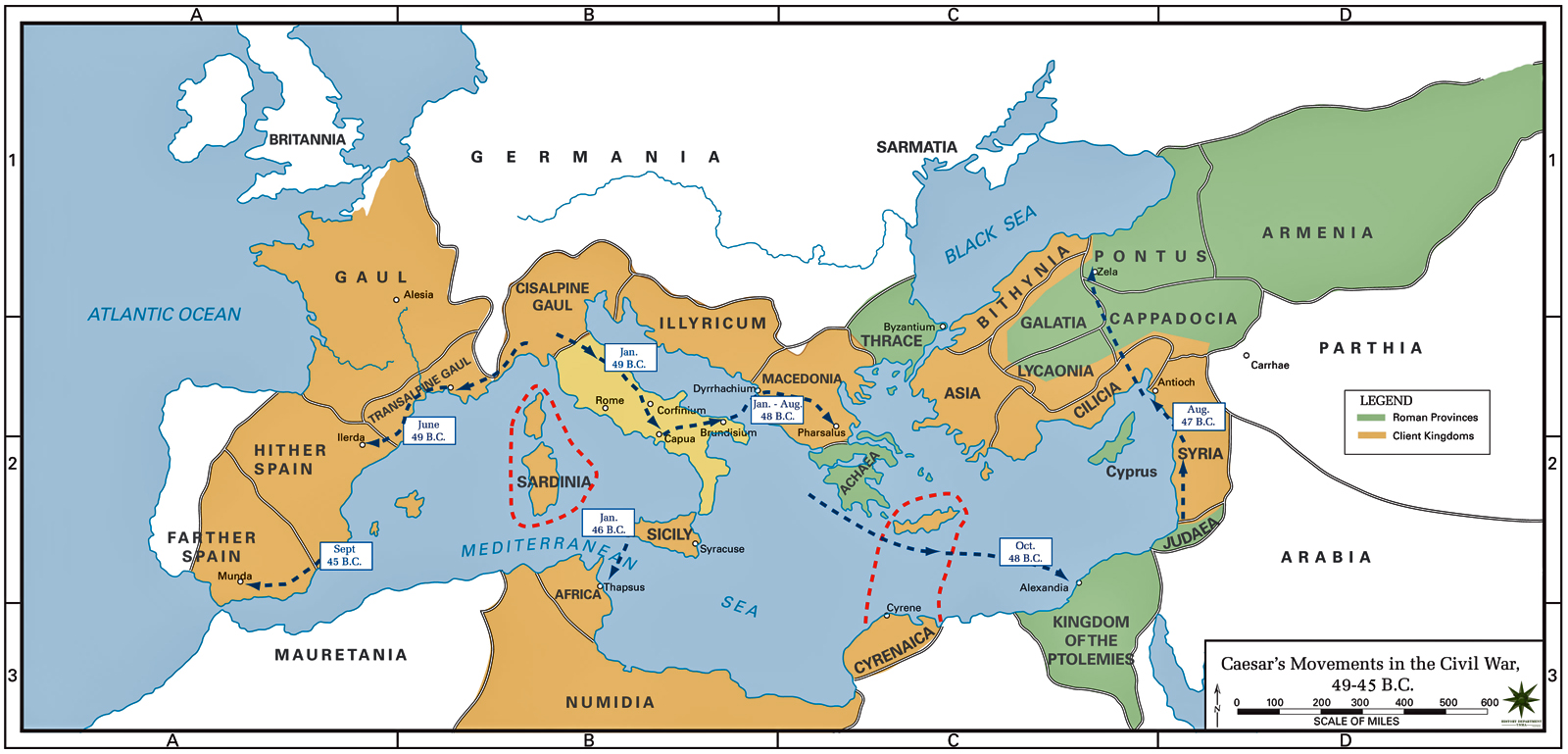
I’ll be using Goldsworthy as primary reference thru the battles, my usual Wiki notes and plagiarizing from the Scenario backgrounds that are to be found. If you are interested in contributing your own AARs for any of the battles that will be fought in the Sertorian/Gallic/Civil war series here please drop me a note, subscribe to the blog on the right at the top —> and lets add your experiences to this series of articles to be released over the next several months.

